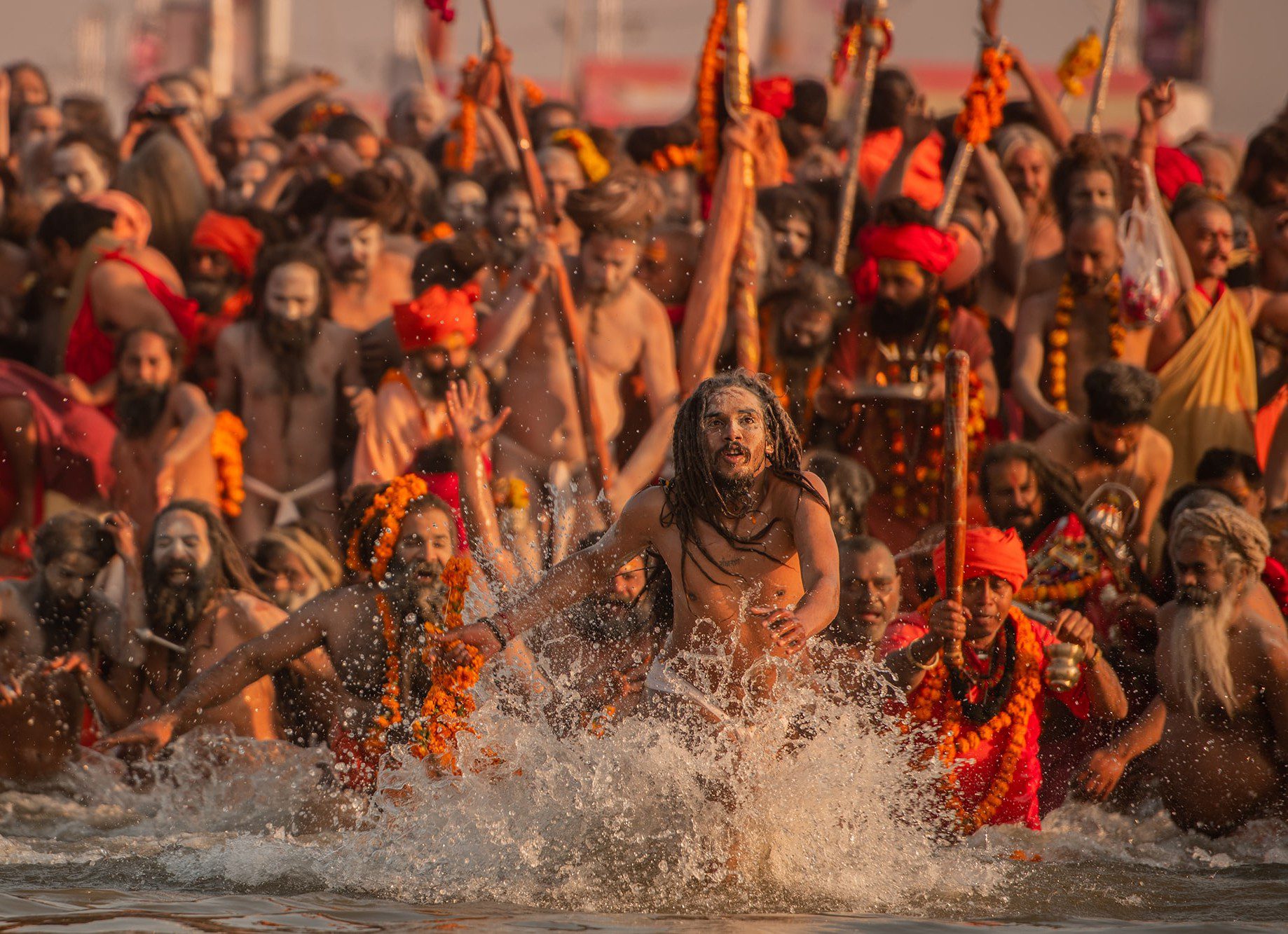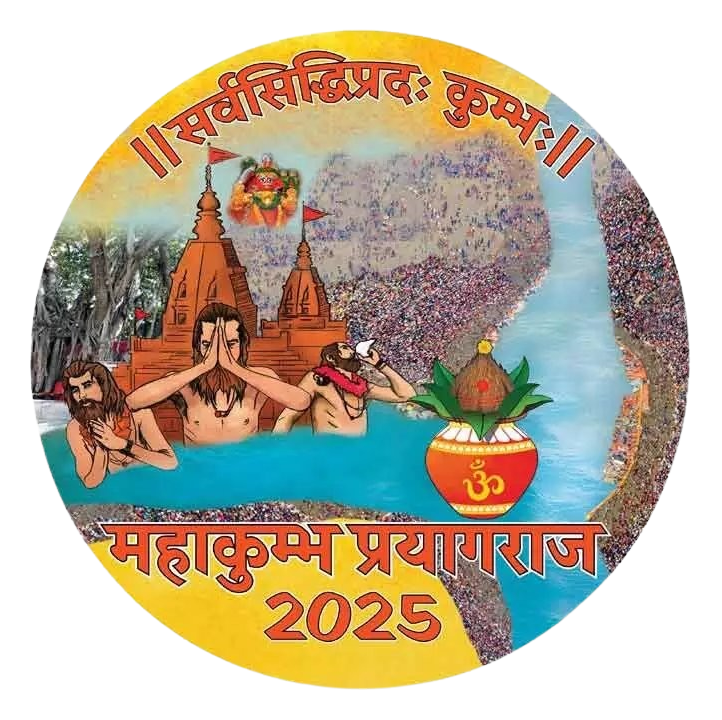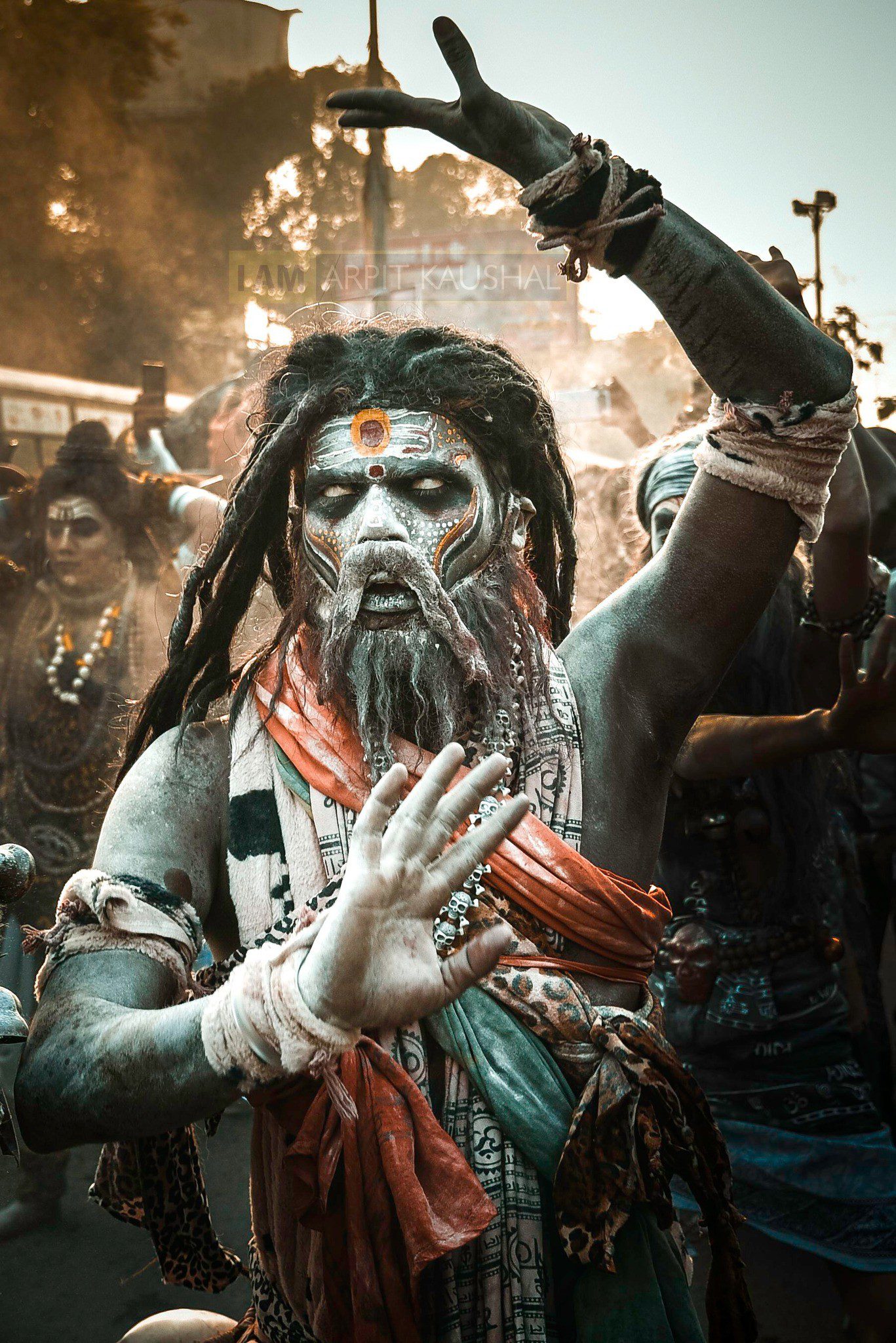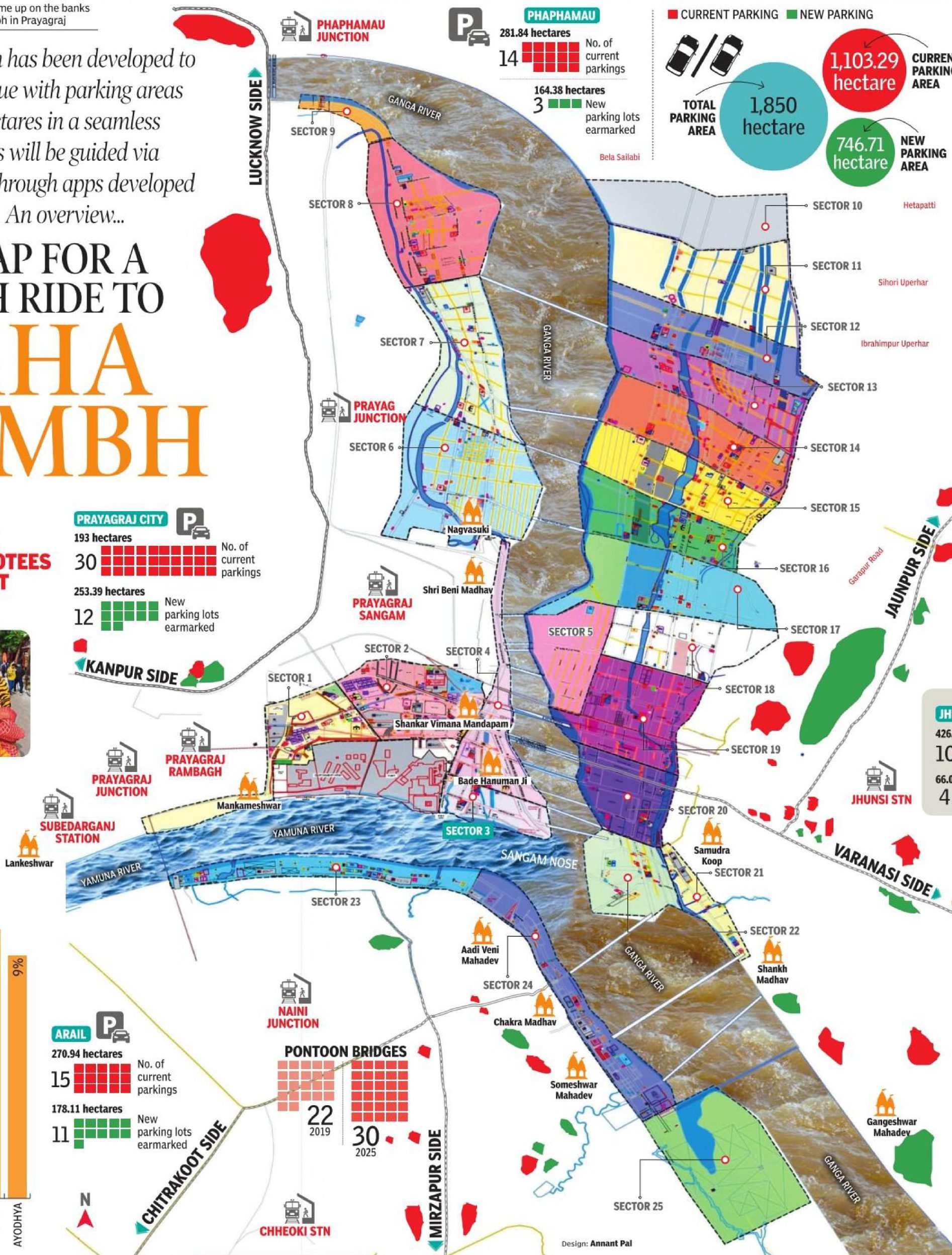

The Maha Kumbh 2025 Companion:
A Local’s Handbook
Tips, Itineraries, and local secrets


WELCOME TO PRAYAGRAJ
Prayagraj, formerly known as Allahabad, is not just a city—it is the confluence of spirituality, history, and tradition.
As a local, I am thrilled to guide you through the Maha Kumbh Mela 2025, a spiritual gathering like no other.
This handbook is your companion to navigate the world’s largest congregation, helping you uncover its mysteries and debunk myths.
This guide aims to:
- Bust common myths surrounding the Kumbh.
- Provide practical travel advice.
- Offer insights from a local’s perspective to make your trip enjoyable and fulfilling.
4 Main Elements of Kumbh Mela Experience
Kalpvas
Kalpvas is a period of spiritual discipline and self- reflection during the Kumbh. Devotees live a simple life on the banks of the Sangam, meditating, fasting, and practicing austerity. Even a brief commitment to Kalpvas allows visitors to experience peace and inner growth amidst the sacred energy of the Mela.
Snan (Holy Dip)
Taking a dip in the sacred waters of the Sangam (the confluence of the Ganga, Yamuna, and the mythical Saraswati) is the heart of the Kumbh Mela. It is believed to cleanse sins, purify the soul, and pave the way for spiritual liberation. Plan your Snan on auspicious dates for maximum spiritual benefit.
Dhyan (Meditation)
Meditation is an essential part of the Kumbh experience, offering a chance to connect with the divine within. Many areas of the Mela are perfect for silent reflection, and some ashrams or Akhadas even host guided meditation sessions. Whether you are a seasoned practitioner or new to meditation, the peaceful environment enhances the experience.
Daan (Charity)
Charity is a core aspect of the Kumbh Mela. Offering food, clothes, or alms to the needy and the ascetics is considered highly auspicious. Daan symbolizes selflessness and helps create a sense of fulfillment by contributing to the well-being of others.
By engaging in Kalpvas, Snan, Dhyan, and Daan, you can fully immerse yourself in the spiritual essence of the Kumbh Mela and leave with a sense of peace, purpose, and renewal.
Keeping the above in mind, let’s start planning your transformative journey to the Mahakumbh!
From dedicating time for Kalpvas and preparing for the sacred Snan, to setting aside moments for serene Dhyan and contributing through meaningful Daan, each step brings you closer to the true essence of this spiritual gathering.
Let’s begin organizing your trip, ensuring you make the most of these divine experiences while exploring the cultural and spiritual wonders of the Mahakumbh.
Preparing for your Journey
| Event | Date | Description |
|---|---|---|
| Paush Purnima | January 13, 2025 | Marks the commencement of the Maha Kumbh Mela |
| Makar Sankranti | January 14, 2025 | First Shahi Snan (Royal Bath) |
| Mauni Amavasya | January 29, 2025 | Second Shahi Snan |
| Basant Panchami | February 3, 2025 | Third Shahi Snan |
| Maghi Purnima | February 12, 2025 | Fourth Shahi Snan |
| Maha Shivratri | February 26, 2025 | Concludes the Maha Kumbh Mela |
WHAT TO PACK
- Clothing: Days are generally sunny and early mornings and nights are cooler. Make sure to pack warm things (especially socks and caps). It might rain at times so keep a windsheeter or a waterproof jacket with you.
- Essentials: Comfortable footwear (you will be walking a lot so wear something that does not hurt your foot), reusable water bottles, power banks, and a first-aid kit.
- Documents: Copies of ID, travel tickets, and emergency contacts.
HEALTH & SAFETY
- Avoid drinking unfiltered water. Water ATM’s are available everywhere.
- Carry basic medicines for common ailments. If you are with kids then make sure to carry all their essential medicines.
- Stick to hygienic eateries to avoid food-borne illnesses. You can enjoy Bhandara’s everywhere. A must eat is ISKCON’s meal. It’s divine!
CULTURAL SENSITIVITY
- Dress conservatively and appropriately. Avoid fancy, uncomfortable clothes.
- Respect local customs and rituals.
- Be patient and understanding in large crowds. It can be overwhelming but thousands of police officials are there to help you. Also, the people are very helpful. You may end up making lots of good friends 🙂
Getting there
HOW TO REACH PRAYAGRAJ
- By Air: Prayagraj’s Bamrauli Airport connects to major cities. You can alternatively, use Lucknow or Varanasi airports and then travel by road to Prayagraj.
Facilities for Pilgrims at the Airport
-
- Shuttle Buses: Regular buses to the Mela grounds on non-peak days.
- E-Rickshaws: Convenient rides available on non- peak days.
- Rest Areas: Comfortable waiting zones for pilgrims.
- By Train: Prayagraj Junction is well-connected across India. There are 8 Railway Stations in and around Prayagraj as listed below:
- Prayagraj Junction (PYJ)
- Prayagraj Rambagh (PRRB)
- Prayagraj Sangam (PYG)
- Prayag Junction (PRG)
- Naini Junction (NYN)
- Prayagraj Chheoki (PCOI)
- Phaphamau Junction (PFM)
- Jhunsi (JI)
- Subedarganj (SFG)
Facilities for Pilgrims at Railway Stations
- Shuttle Buses: Regular buses to the Mela grounds on non-peak days.
- E-Rickshaws: Eco-friendly rides available from all stations on non-peak days.
- Walking Signage: Clear signs guiding routes to the Mela area.
- Entry & Exit Routes: Dedicated paths for smooth crowd management.
- Rest Areas: Relaxation zones for pilgrims at all stations.
- By Road: Buses and taxis operate from nearby cities.
Facilities for Pilgrims at Bus Stations
- Shuttle Buses: Convenient bus services to the Mela grounds.
- E-Rickshaws: Easy and eco-friendly travel options.
- Rest Areas: Comfortable spaces for pilgrims to relax.
NAVIGATING WITHIN THE CITY
- Local e-rickshaws, buses, or app-based cabs are available.
- Dedicated shuttle services operate to and from the Mela grounds.
PARKING FACILITIES
Follow this link to get details of all parking areas https://kumbh.gov.in/en/parking
MEDICAL FACILITIES
Follow this link for details of all hospitals in the Kumbh Area https://kumbh.gov.in/en/MedicalFacilities
Reaching Sangam
Take an Auto/Cab to Kydgunj Boat Club
- This is a convenient starting point to board a boat to the Sangam.
Hire a Boat to Sangam
- Boats are available at varying prices, ranging from
₹200 to ₹2500 per person, depending on the type of boat and your negotiation skills.
Return to the Same Spot
- After your holy dip (Snan), the boat will bring you back to Kydgunj Boat Club.
Pro Tip: Negotiate Like a Local
- Avoid appearing like a tourist. Speak confidently, know the general rates, and don’t hesitate to bargain for a fair price
Places to Stay
A wide variety of accommodations are available, ranging from simple tents to luxurious Swiss cottages.
Myth Busted: “Everything is very expensive.”
This is only partially true. While some high-end options can be costly, there are plenty of affordable choices if you’re aware and do a bit of research. Being attentive and booking early can help you secure a decent place to stay within your budget.
Some of my recommended places (based on personal experience)
HOTELS:
- Hotel Prayag (near Prayagraj Junction; exit from Khushi Bagh side) – https://www.prayaggroupofhotels.com/hotel- prayag.html
- Hotel Rama Continental (Civil Lines; bit far from the kumbh area) – https://hotelramacontinental.in/
TENTS:
- Rishikul Kumbh Cottages https://www.rishikulkumbhcottages.com/
- Parmarth Niketan Ashram https://kumbhamela.org/accommodation/
- ISKCON
https://iskconprayagraj.org/maha-kumbha- accommodation/
There are many more good and affordable options but I have personal experience with these.
AIRBNB:
https://www.airbnb.co.in/rooms/1337451124955357289? guests=1&adults=1&s=67&unique_share_id=337f6f8d-6c63- 4a6b-b235-f0a3d292d631
BOOKING TIPS
- Book early to secure accommodations as options fill up quickly during the Kumbh.
- If you plan for Amrit Snan days, the stay could get little on the expensive side.
- Stay close to the Sangam or main bathing ghats if convenience is a priority, or opt for quieter areas (trail ghat and other areas) if you want to avoid crowds.
- Check official Mahakumbh websites or government- approved travel agencies for reliable and safe bookings, especially for tents and camps.
- Keep hard copies of all booking confirmations (accommodation, transport, etc.) as internet connectivity might be unreliable at the site.
Must visit Akhara’s & Ashram’s
EXPERIENCE THE AKHARA’S
If you truly want to experience “The Kumbh”, a visit to the Akharas is a must. These are the heart and soul of the event, where the spiritual and cultural essence comes alive. The grandness of the Kumbh truly lies in the Akharas, and I promise you’ll be as mesmerized as I am.
What are Akharas?
Akharas are monastic orders or sects of Hindu ascetics and saints, each with a unique philosophy and tradition. They play a central role in the Kumbh Mela, leading the grand Shahi Snan processions and offering a glimpse into India’s rich spiritual heritage.
- Juna Akhada
- Nirmal Akhara
- Naya Udasin Akhara
- Kinnar Akhara
All Akharas are stationed in Sector 16, 19 and 20. You will have to cross the pontoon bridge to reach there if you are coming from Bandh area side. Pontoon bridge number 7 will lead directly to Sector 20 Akhada’s.
MUST VISIT ASHRAM’S
Parmarth Niketan Ashram
One of the largest ashrams in Rishikesh, with a branch in Prayagraj during the Kumbh, Parmarth Niketan is renowned for its spiritual teachings, yoga, and Ganga Aarti. A serene place to deepen your spiritual journey.
Location: Sector 23 (Arail side), Kumbh Mela area
ISKCON Prayagraj
Dedicated to Lord Krishna, the International Society for Krishna Consciousness (ISKCON) Ashram offers vibrant kirtans, devotional teachings, and prasadam (sanctified food) to visitors.
Location: Sector 19, Kumbh Mela area
Swami RamBhadraCharya Ji
He is one of the current four Jagadguru Ramanandacharyas of the Ramanand Sampradaya and has been conferred on this position since 1988. He is a multilingual person and speaks 22 languages.
Location: Sector 6, Kumbh mela area
KailshaNand Giri ji Maharaj
Swami Kailashanand Giri Ji Maharaj is a Hindu spiritual guru, scholar, and writer. He is the Acharya Mahamandaleshwar of Niranjani Akhara. It’s a beautiful shivir and a must visit.
Location: Sector 9, Kumbh Mela Area
Meeting the Naga Sadhu’s


The Naga Sadhus are one of the most fascinating and revered groups at the Mahakumbh. Here are some key points to keep in mind if you wish to interact with them:
Who Are They?
Naga Sadhus are ascetics who have renounced worldly life to focus on spiritual enlightenment. They are often recognized by their ash-covered bodies, dreadlocks, and minimal/no clothing.
Approach with Respect
Always greet them respectfully, using phrases like “Har Har Mahadev” or “Om Namo Narayan” to initiate a conversation. Avoid intrusive questions about their lifestyle unless they seem open to talking.
Take something to offer
Be it a small donation or something to eat like ladoos/
fruits etc, take something to offer and seek their blessings.
Photography Etiquette
Seek permission before taking photos or videos of them. Some may not mind, but others may find it disrespectful.
Engaging in Conversations
If they’re in the mood to chat, they may share spiritual insights or stories. Be patient and listen carefully; it’s a rare opportunity to learn from them.
Be Mindful of Their Space
They are often in deep meditation or performing rituals. Avoid disturbing them during these times.
Meeting Naga Sadhus is a unique cultural and spiritual experience. Respect their traditions, and you may walk away with profound insights.
Unmissable attractions
MAHAKUMBH DIGITAL EXPERIENCE CENTRE
Digital Mahakumbh Experience Centre has been opened here that digitally portrays the mythological stories behind the Mahakumbh Mela using Artificial Intelligence (AI) Virtual Reality (VR), Augmented Reality (AR), light detection and ranging (LiDAR) technology, LED displays and holograms.
Ticket price : Rs. 50 per person
Location: Sector 3-4 (Kumbh mela) Opposite Bade haumanji mandir.
RAM MANDIR REPLICA
A stunning replica of the Ram Mandir has been constructed at the Mahakumbh in Prayagraj, with an investment of ₹3 crore. This intricately designed structure serves as a tribute to the grandeur of the original temple, adding cultural significance to the spiritual event.
Ticket price : Rs. 50 per person
Location: Sector 1 (Kumbh Mela) Ground next to New Chungi Bairhana Overbridge.
BADE HANUMANJI MANDIR CORRIDOR
The Bade Hanuman Ji Corridor in Prayagraj (Allahabad) is a significant religious and cultural development around the historic Bade Hanuman Mandir, located near the Sangam.
Location: Bandh area, Sangam
AKSHAYVAT CORRIDOR
The corridor stretches from the Akshayavat tree, located by the Yamuna River inside Akbar Fort in the Sangam area, and ends at Saraswati Koop through Patalpuri.
Location: near bade hanuman mandir
SHANKAR VIMAN MANDAPAM
The Shankar Viman Mandapam temple has three levels: the first houses Adi Shankaracharya’s statue, the second has idols of Devi Kamakshi, 51 Shakti Peethas, and Venkateswara (Balaji) with 108 Vishnu Peeths, while the top floor features a Sahasra Yoga Linga surrounded by 108 Shiva Lingas.
Location: Near bade hanuman mandir, bandh area.
NAGVASUKI TEMPLE
The Nagvasuki Mandir in Prayagraj, Uttar Pradesh, is a significant Hindu temple dedicated to Lord Vasuki, the king of snakes.
Believed to alleviate Kaal Sarpa Dosha, it is said to originate from Lord Vasuki resting here after churning the ocean of milk in Vedic times.
Location: Daraganj (near Kumbh mela area)
SHIVALAY PARK
The park at Mahakumbh Prayagraj, shaped like India’s map, features replicas of 12 Jyotirling temples, highlighting the country’s spiritual heritage.
Ticket price:Rs. 50 per person (Mon-Thu) and Rs.100 on (Fri- Sun)
Location: Arail
SHRINGVERPUR DHAM
Located 30-35 km from the city, it features Nishadraj Park with a grand corridor and a magnificent 54 ft tall statue of Ramji and Nishadraj.
Location: Nishadraj Karelabagh G T V Nagar
5 CRORE 51 LAKH RUDRAKSHA SHIVLINGS
The site features 12 shillings, each 12 feet tall, adorned with 5 crore 51 lakh rudrakshas, creating a breathtaking spectacle.
Location: Sector 6 (Kumbh mela), Mauni baba Ashram, Nagasaki dear
TIRUPATI BALAJI TEMPLE
An 8-ft tall idol of Balaji is located here, with a Palki Shobha Yatra held every evening.
Location: Sector 6, Bajrang das marg (Kumbh mela)
UTTAR PRADESH DARSHAN MANDAPAM, KALA KUMBH AND KALA GRAM
All three sites are close to each other, and Kalagram often hosts
cultural events starting at 4 PM. Location: Sector 7 (Kumbh mela)
If you feel adventurous
ENTARTICA VILLAGE
If you’re seeking adventure and unforgettable experiences, make sure to visit Entartica Village in Sector 23. It’s the perfect spot for pilgrims, thrill-seekers, and families.
- Enjoy Triveni Sangam Darshan Rides and take in a divine view of the confluence.
- Soar through the skies with exciting aerosports and enjoy breathtaking aerial views from Hot air Balloon
- Dive into adventure with kayaking, jet skiing, and paddle boating.
- Feel the rush with zip-lining and rope activities!
You can pre-book your tickets here https://entartica.com/kumbh-mela/
DRONE SHOW
A three-day drone show spectacle in the Sangam area will be yet another highlight of this Mahakumbh. Starting from 24th January to 26th January at Sangam nose.
WATER LASER SHOW
The public can enjoy the water laser show for free without any ticket. Two shows will be shown every day between 7 pm to 9 pm and the duration of each show will be 45 minutes.
The show will be displayed at Kali Ghat near the Boat Club. Sector 2 of Kumbh Mela.
HELICOPTER RIDE
Book Your Helicopter Ride in Mahakumbh
![]()
![]()
Online booking:
https://upstdc.co.in/ https://booking.pawanhans.co.in/
Ride Charges – 1296/- Per Person
Please note that Pawan Hans Limited is the ONLY authorised provider of these services by the government.
Ganga Pandal (Parade ground)
In a grand initiative to showcase India’s rich cultural heritage, the Ministry of Culture has setup Ganga Pandal in Mahakumbh Mela with a capacity of 10,000 people.
Below are the performers:
Jan 25 – Ravi Tripathi Jan 26 – Sadhana Sargam Jan 27 – Shaan
Jan 31 – Ranjani & Gayatri Feb 10 – Hariharan
Feb 23 – Kailash Kher
Feb 24 – Grand Finale by Mohit Chauhan
Location: Sector 1, Parade ground
Suggested Itinerary for short trips
1 DAY STAY
Day Visit to Kumbh Mela: What to Cover
-
- Start with a Holy Dip at the Sangam
- Begin your journey at the confluence of the Ganga, Yamuna, and Saraswati rivers. Taking the Snan here is considered the most sacred act to purify your soul and start your day with positivity.
- Visit Akhadas and Meet Saints
- Explore the Akhadas (spiritual camps), where you can interact with Naga Sadhus and other ascetics. Witness their rituals, learn about their lifestyles, and gain spiritual insights.
- Explore Cultural and Spiritual Stalls
- Visit exhibitions showcasing handicrafts, spiritual literature, and cultural heritage. These stalls provide a glimpse into India’s rich traditions and offer unique souvenirs.
- Visit Nearby Temples
- Explore iconic temples such as Nagvasuki Temple, Bade Hanuman Mandir, Akshayvat corridor, Shankar Viman Mandapam each with a distinct spiritual significance.
- Experience Community Langar
- Participate in the langar (free community meals) for a soulful experience of charity and togetherness. Alternatively, enjoy local delicacies at the food stalls.
- Participate in Dhyan (Meditation)
- Join a meditation or chanting session at one of the many ashrams or spiritual camps. This is an opportunity to practice inner reflection and connect with the divine.
- Attend the Ganga Aarti
- Witness the stunning evening Ganga Aarti at the Sangam. The glowing diyas floating on the river create a mesmerizing and unforgettable experience.
- Visit Shivalay Park
- If time permits, see the shivalay park situated in Arail.
- Immerse in Cultural Performances
- Watch traditional music, dance, and mythological plays that reflect India’s cultural richness.
- Conclude with Daan (Charity)
- End your visit by giving Daan, such as food, clothes, or alms, to the needy or ascetics. This act of selflessness is integral to the Kumbh experience.
- Start with a Holy Dip at the Sangam
2 DAY STAY
Day 1: Immerse in Spirituality and Culture
- Holy Dip at the Sangam
- Begin your Kumbh journey with a sacred bath at the Sangam, the confluence of the Ganga, Yamuna, and Saraswati rivers. This ritual is believed to cleanse sins and bring spiritual renewal.
- Visit Akhadas and Interact with Sadhus
- Explore the Akhadas, home to Naga Sadhus and other ascetics. Learn about their unique practices and the spiritual significance of their way of life.
- Digital Kumbh Experience Centre
- Visit this state-of-the-art facility to dive into the history, traditions, and stories of the Kumbh Mela through virtual reality, 3D projections, and interactive displays. It’s an unmissable addition to your trip.
- Explore Cultural and Handicraft Stalls
- Stroll through stalls showcasing regional crafts, spiritual books, and souvenirs. These stalls offer a glimpse into the vibrant cultural and artistic heritage of India.
- Attend Spiritual Sessions
- Join a guided meditation or chanting session at one of the ashrams or spiritual camps. Experience the peace and serenity that the Kumbh is known for.
- Visit Temples in the Area
- Stop by Nagvasuki Temple and Bade Hanuman Mandir, both significant spiritual landmarks. Don’t miss the Balaji Temple to witness the evening Palki Shobha Yatra.
- Ganga Aarti
- Conclude your first day with the mesmerizing Ganga Aarti at the Sangam. The sight of glowing lamps and the rhythmic chants will leave you spellbound.
Day 2: Dive Deeper into the Kumbh Experience
- Start with Kalpvas Rituals
- Spend your morning experiencing the rituals of Kalpvas. Observe how devotees live simply, meditate, and pray near the riverbanks to attain spiritual growth.
- Nishadraj Park and Ramji Statue
- Visit this nearby attraction featuring a grand corridor and 54-ft statues of Ramji and Nishadraj. The park is steeped in mythology and offers beautiful photo opportunities.
- Digital Kumbh Experience Centre (if missed on Day 1)
- If you couldn’t visit on the first day, this is the perfect time to explore the Digital Kumbh Experience Centre.
- Attend Cultural Performances
- Watch folk dances, music, and mythological plays that are performed throughout the day at various stages across the Mela grounds.
- Langar and Daan
- Participate in the langar (community kitchen) for lunch and perform Daan (charity), such as donating food, clothes, or alms.
- Temple Hopping and Evening Meditation
- Visit more temples or spend the evening meditating along the serene banks of the river. The calm atmosphere is ideal for Dhyan (meditation).
- Conclude with a Last Ganga Aarti
- End your journey with another Ganga Aarti, leaving you with unforgettable memories of the Kumbh Mela.
This 2-day itinerary allows you to fully immerse in the spiritual, cultural, and technological marvels of the Kumbh Mela while ensuring a balanced and enriching experience.
Food & Souvenirs
THINGS TO EAT!
- Dehati rasgulla – Baihrana
- Elchico Cafe – Civil Lines
- Rajaram lassi wale – Loknath area
- Netram kachauri
- Kali gajar ka halwa at Rajaram lassi wale – Loknath
- Hari ke samose – Hari ram & sons – Loknath area
WHAT TO BRING BACK? (BLESSINGS FROM KUMBH)
- Gangajal
- Sand from Ganga ghat (keep it in your tulsi plant)
- Buy Rudraksha mala or fresh Rudraksha fruits.
- Any other local things you find that would help local artisans.
Amrit Snan days
The next and biggest Amrit Snan is on 29th January. Here’s a practical list of points to follow on Amrit Snan days:
- Wear Modest and Comfortable Clothing: Opt for light, traditional attire which are easy to dry and culturally appropriate for the occasion.
- Stay Hydrated: Carry water bottles and drink regularly, as walking and waiting in large crowds can lead to dehydration. Water ATM’s are available everywhere,
- Pack Essentials: Bring essentials like a small towel, a change of clothes, waterproof bags for valuables, and a first-aid kit.
- Travel Light: Avoid carrying large bags or unnecessary items as they might hinder your movement in the crowd.
- Follow Ghat Rules: Use only designated ghats for bathing and follow the instructions of police and volunteers for safety.
- Avoid Rush Hours: If possible, avoid peak times when crowds are heaviest, such as early morning or evening.
- Be Cautious in Water: The river currents can be strong. Stay within the safety ropes or shallow areas and avoid going too far into the water.
- Keep Identification Handy: Carry a government-issued ID card, especially if you’re traveling from outside the city.
- Travel in Groups: Stick with family or friends to avoid getting separated in the crowd. Designate a meeting point in case anyone gets lost.
- Secure Valuables: Avoid wearing expensive jewelry and keep your belongings in a waterproof pouch
- Avoid Plastic: Help maintain cleanliness by not bringing or using plastic bags or bottles in the mela area.
- Emergency Contacts: Save the helpline numbers of local authorities, medical services, and mela organizers for emergencies.
- Avoid Alcohol and Smoking: Refrain from any activities considered inappropriate during such a spiritual event. People may not like it and it can cause trouble.
- Be Patient: Expect delays and cooperate with authorities managing the large crowds.
- Leave Early: After your Snan, avoid lingering unnecessarily at the ghats to make space for other pilgrims.
These specific tips ensure a smooth and enriching experience during the Amrit Snan days.
For Kids & Older people
For Children:
- Identification Tags: Write the child’s name, guardian’s contact details, and address on an identification tag and attach it securely to their clothing.
- Keep Close Supervision: Always hold the child’s hand or keep them within sight to prevent separation in the crowd.
- Comfortable Clothing: Dress them in weather- appropriate, comfortable clothes and sturdy footwear.
- Carry Essentials: Bring snacks, water, a small towel, and any necessary medications for the child.
- Avoid Peak Times: Visit the ghats during less crowded hours to ensure their safety and comfort.
- Use Designated Areas: Opt for family-friendly zones or specific ghats that are safer and less crowded for children.
- First Aid Knowledge: Learn the location of nearby first-aid centers in case of minor injuries or illnesses.
- Entertainment: Carry small toys, books, or gadgets to keep them occupied while waiting.
- Avoid Deep Water: Ensure children stay in shallow areas of the ghats and do not go beyond safety ropes.
- Regular Hydration: Make sure they drink water frequently to stay hydrated.
For Older People:
- Health Check Before Travel: Ensure they have a medical consultation and carry necessary medicines, including prescriptions.
- Avoid Crowds: Plan their visit during off-peak hours to reduce the strain of navigating heavy crowds.
- Use VIP or Special Ghats: Opt for ghats with facilities designed for seniors or differently-abled individuals.
- Stay Hydrated and Fed: Provide light, easily digestible food and plenty of water. Avoid heavy meals before the Snan.
- Accessible Clothing: Dress them in simple, easy-to- manage clothes and sturdy, non-slip footwear.
- Transportation Planning: Use designated parking areas, shuttle services, or private vehicles to minimize walking distances.
- Warm Clothing: If attending early in the morning or at night, ensure they are dressed warmly to avoid chills.
- Stay in Groups: Ensure older individuals are always accompanied and do not get separated.
- Alert Authorities if Necessary: Inform the volunteers or police immediately in case of any distress or disorientation.
- Rest Facilities: Utilize resting areas or senior citizen facilities provided at the mela.
Tips for International Visitors
BEFORE ARRIVAL
Visa and Documentation:
-
- Ensure your visa is valid for the duration of your stay in India.
- Carry multiple copies of your passport, visa, and ID. Keep digital copies stored safely online.
Vaccinations and Health:
-
- Check for required vaccinations (e.g., typhoid, cholera, hepatitis A/B).
- Pack basic medications for common issues like fever, diarrhea, or allergies.
Travel Insurance:
-
- Purchase comprehensive travel insurance covering health, theft, and emergencies.
Research Accommodation:
-
- Book accommodation well in advance. Look for camps, ashrams, or hotels close to the mela area.
Language Preparation:
-
- Learn basic Hindi phrases or download a translation app for easier communication.
DURING THE MAHAKUMBH
Cultural Sensitivity:
-
- Dress modestly in traditional or simple clothing (e.g., loose cotton attire) to respect local customs.
- Remove shoes before entering temples or sacred spaces.
Currency and Payments:
-
- Carry Indian rupees in small denominations for local transactions. Many small vendors don’t accept cards or foreign currencies.
- Use authorized currency exchange services.
Crowd Navigation:
-
- Stay alert and avoid entering extremely crowded areas alone.
- Follow the directions of volunteers and police.
Hydration and Food:
-
- Drink only bottled water with a sealed cap to avoid contamination.
- Eat at hygienic stalls or carry pre-packaged food. Avoid raw or uncooked items.
Respect Rituals:
-
- Observe rituals quietly and respectfully, even if you don’t participate.
- Do not photograph rituals or pilgrims without permission.
Safety and Security:
-
- Keep valuables like wallets and passports in secure, waterproof pouches.
- Avoid displaying expensive jewelry or gadgets.
- Save emergency contact numbers, including local police and embassy contacts.
Transportation:
-
- Use official shuttle services or registered cabs for commuting. Avoid overcrowded public transport.
- Plan your return route in advance, as roads may be closed or rerouted during peak times.
Communication:
-
- Carry a local SIM card or activate international roaming to stay connected.
- Share your travel plans and location with family or friends back home.
Stay Clean:
-
- Use public restrooms provided by authorities and dispose of waste responsibly.
- Carry a small hygiene kit with tissues, hand sanitizer, and wet wipes.
Stay in Groups:
-
- Travel with friends or fellow pilgrims and designate meeting points in case of separation.
Debunking Myths
MYTH 1: IT’S TOO CROWDED TO ENJOY
- Reality: While the Mahakumbh attracts millions, visiting early or late in the day avoids the crowds. The event is spread out, making it possible to enjoy it without being overwhelmed.
MYTH 2: ONLY RELIGIOUS PEOPLE ATTEND
- Reality: Anyone can attend, not just religious followers. It’s a cultural and spiritual experience open to all.
MYTH 3: IT’S TOO EXPENSIVE
- Reality: You can attend on a budget. There are affordable accommodation options, free rituals, and low-cost food stalls. There are also delicious and free Bhandara’s serving delicious food to everyone daily.
MYTH 4: IT’S UNSAFE FOR INTERNATIONAL VISITORS
- Reality: The event is secure with plenty of police, volunteers, and emergency services to ensure safety.
MYTH 5: ONLY SWIMMERS CAN TAKE THE HOLY DIP
- Reality: The holy dip is for everyone. There are safe areas and lifeguards to ensure everyone can participate safely.
MYTH 6: ONLY HINDUS CAN ATTEND
- Reality: People of all faiths are welcome to visit and experience the Mahakumbh.
MYTH 7: YOU NEED TO BE FIT TO ATTEND
- Reality: The event is accessible to people of all fitness levels, with assistance for those who need it.
MYTH 8: YOU MUST ATTEND IN A GROUP
- Reality: You can attend alone or in a small group. It’s a great place to meet new people.
MYTH 9: IT’S JUST ABOUT THE HOLY DIP
- Reality: There are many activities, including cultural performances, spiritual talks, and food stalls, to explore beyond the dip.
Emergency Contacts
Image Credit: TOI, Lucknow
In the event of a fire or emergency during the Mahakumbh, promptly contact the following numbers:
- Fire Service: 101
- Police Emergency Service: 112
- Ambulance Service: 108
- Prayagraj City Helpline: 1920
Kumbh Map


The Maha Kumbh Mela is a once-in-a-lifetime experience. Embrace the chaos, connect with people, and take back memories that will last forever.


